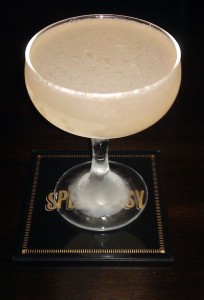Although many of today’s great cocktail discoveries come from reviving classic as well as obscure drinks from pre-Prohibition bartending literature, the Jasmine Cocktail can be traced to Paul Harrington from the mid 1990’s. For a complete discussion of this drink, I must defer to Robert Hess.
I decided to see what would happen if I fed the ingredients for this drink into my algorithm, and see what it predicted. For the ingredient list, I used:
- Beefeater Gin
- Campari
- Combier Liqueur D’Orange
- Lemon Juice
- 1-to-1 simple syrup.

Project Calcuhol’s Jasmine.
This is similar to the original recipe’s ingredient list except that Combier is replacing Cointreau and simple syrup is added so that the burden of providing sweetness to the cocktail does not rest solely on the Combier (because that would require a whole lot of it). Check out the recipe here:
Jasmine Recipe
The calculated recipe brings the lemon juice up by quite a bit compared to the original recipe, and the amounts of the gin, Campari, and orange liqueur are split more evenly, which is the algorithm’s attempt to avoid any one of them dominating the drink. This is an interesting reinterpretation of this modern classic, different from both Harrington’s and Hess’ version. To my tastes, the balance is flawless and this version retains the characteristic taste of grapefruit juice, if not even more so, of the original.







